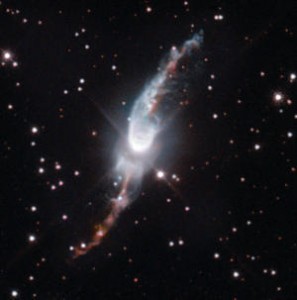Have you wondered what was the solar system was like in the very beginning. How does one get from a mixed ball of stardust to a giant planet with concentric structure such as inner and outer core and layered atmosphere?
Surprising, it turns out that a giant planet indeed has it own unique history. According to the nebular hypothesis, a planet originally is distilled from a rotating cloud of dust particles and gases known as the solar nebula. These elements forming the gases and particles originally are byproducts of nuclear reactions within some other stars. Then they were scattered everywhere after cataclysmic explosions that mark the death of stars. These essential elements in the cloud were hydrogen, helium, oxygen, silicon and carbon.
Evenutally the dust cloud began to rotate and contract. It did not shrink into a round ball as some early scientists expectm but into a disk. Gravity attracted the particles to one another, and clumps of these space matter began to form. Smaller particles merged to build clumps up to several meters in diameter, and these larger bodies in turn swept up finer particles within their orbital paths. Although much are known about these planetary nebula, the researches are still ongoing.
On October 11th, 2012, scientists discovered a planetary nebula in the making. Among these numerous stars, planetary nebulae are probably one of the most fascinating objects to behold in the night sky. The names arises becuase most of these objects resembled a planet when they were first discovered through early telescopes. The NASA/ESA Hubble Space Telescope reported that the observed planetary nebula is Hen 3-1475. It glows brightly because of the radiation that arise from a hot compact core that reains after the outer envelope is ejected. These radiation is so powerful that they make the gossamer shells shine.
Several days after the initial discovery, scientists at Hubble Space Observatory reported that Hen 3-1475 is positioned i the constellation of Sagittarius roughly 18,000 light-years away from us. The central star is more than 12,000 times as bright as our sun. The most striking part about the nebula is its two S-shaped jets that emerge from the pole regions of the central star. Experts report that these jets are long outflows of gas particles moving at a speed of hundreds of kilometers per second.
Hen 3-1475. (Credit: ESA/NASA)
The formation of these bipolar jets has left many space scientists searching for explanations for a long time. Many experts are still currently investigating the possiblities behind these observations. Although no clear evidences are found, some experts suggested that the unique shape of the planetary nebula is due to a central source that ejects streams of gas in opposite directions and these processes only occur once every couples of thousand years. Modern researches is still ongoing and more updates will be provided as soon as any breaking news emerge.
More stories can be found at:
http://www.sciencedaily.com/releases/2012/10/
121011142336.html
– Jing Xiang Yang





